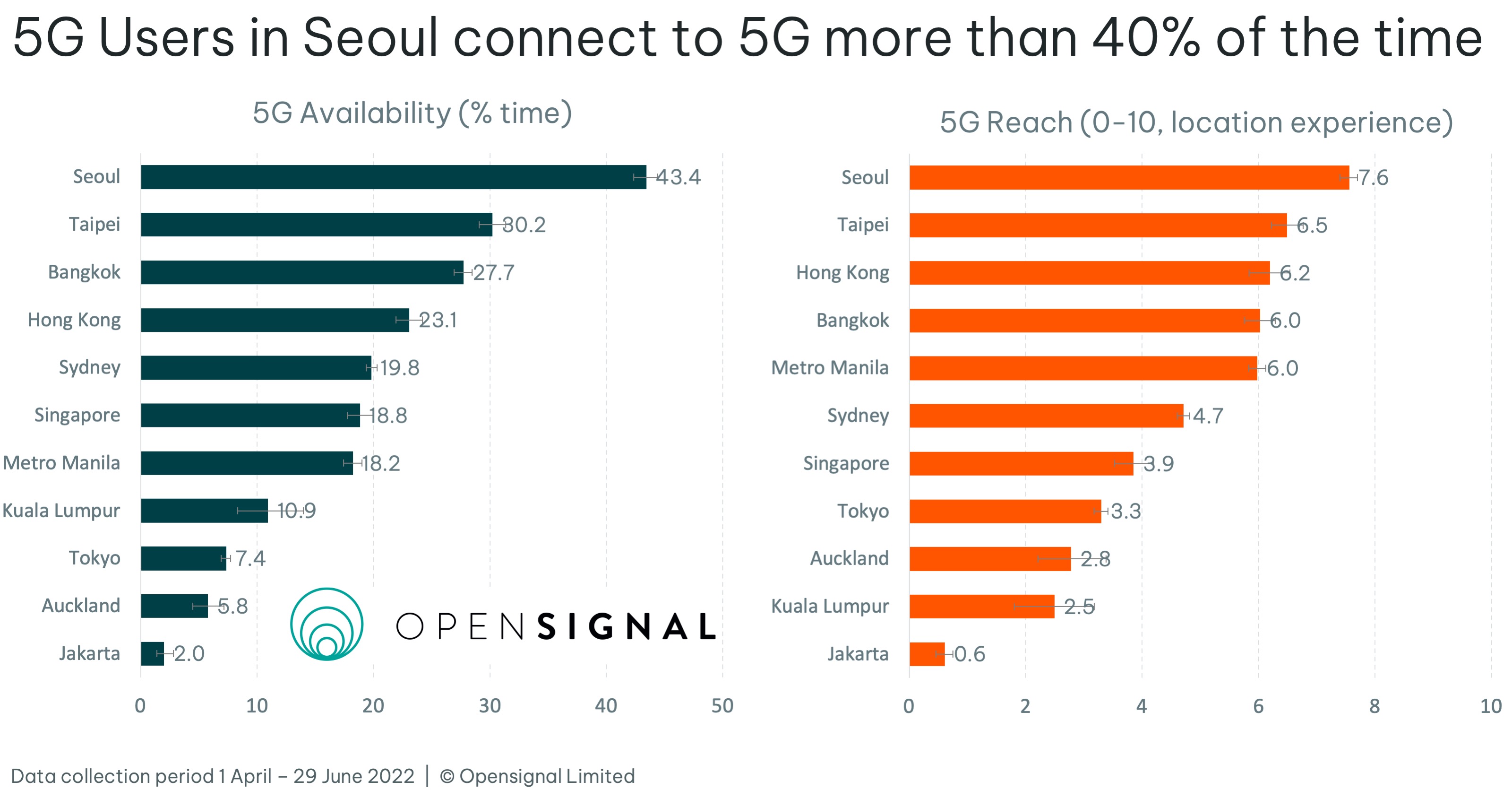In this new analysis, Opensignal has analyzed the 5G Experience in 11 of the largest cities in the Asia Pacific region. 5G will eventually become a ubiquitous mobile technology and is traveling down the same path as 4G to offering national service. However, for now 5G comes into its own in urban areas where operators have sought to serve the greatest number of users quickly and have used new 5G mid-band spectrum to help relieve congestion on existing 4G networks.

Perhaps unsurprisingly, given South Korea’s dominance in this category in our recent Benchmarking the Global 5G Experience update, our users in Seoul observed the fastest average 5G download speeds. They clocked up 453.1 Mbps, which was 76.5 Mbps or 20.3% faster than the speeds observed in the next fastest city, Kuala Lumpur. Speaking of which, our users in Kuala Lumpur enjoyed the fastest 5G Upload Speed — 52.8 Mbps, which was 12.2-13.7 Mbps faster than the 5G Upload Speed seen in the next two cities — Seoul (40.6 Mbps) and Taipei (39.1 Mbps).
Kuala Lumpur tops the table because of the specific market situation with 5G in Malaysia. Many of the country’s operators are not yet using Malaysia’s national wholesale 5G network — Digital Nasional Berhad (DNB). The main operator that is using DNB — Yes — only launched relatively recently. Yes began with a soft launch in December 2021 before doing a full commercial launch in late May 2022. As a result, the DNB is currently operating with much fewer users and a much lighter load than most 5G city networks across the region.

Turning to the 5G experience of our users when streaming mobile video (5G Video Experience) or playing multiplayer mobile games (5G Games Experience), our users in Taipei and Auckland had the best 5G Video Experience with their statistically tied scores of 80-81.3 points on a 100 point scale. Singapore does well in both 5G video streaming and 5G multiplayer gaming, ranking third for 5G Video Experience as part of a statistical tie with Hong Kong and Seoul — and sharing the top spot for 5G Games Experience with Seoul and Jakarta due to a three-way statistical tie. This means 5G users in Seoul, Singapore and Jakarta enjoyed the best experience when playing real-time multiplayer mobile games over 5G connections.

So far we’ve examined the 5G experience alone — but for 5G to provide consumers with compelling reasons to adopt the new technology, it needs to offer superior performance to what users have already been experiencing with 4G. While it is still early days for 5G in Malaysia, Kuala Lumpur’s inhabitants saw a huge difference in their average download speeds when they connect to 5G instead of 4G. In fact the city’s 5G Download Speed score is an incredible 19 times higher than its 4G Download Speed score. Again, this is because of the recent launch of 5G in Malaysia and the relatively light usage of the DNB — see the discussion above.
Metropolitan Manila is in second place with a 5G Download Speed score that was 7.3 times faster than its average 4G upload speeds. In addition, when we look at the improvement in users’ experience when streaming mobile video, our users in Metropolitan Manila saw the greatest uplift — their 5G Video Experience score of 71.6 was 54% higher than their 4G Video Experience.

However, for users to benefit from the improved experience that 5G can provide, they need to be spending a significant proportion of their time connected to 5G and be able to find a 5G signal in the locations they visit. Looking at 5G Availability, the amount of time that our 5G users were able to connect to 5G varies widely — from an impressive 43.4% in Seoul to just 2% in Jakarta. Seoul leads by a significant margin of 13.2 percentage points over Taipei and 15.7 percentage points ahead of third placed Bangkok.
With 5G Reach we see a similar pattern to 5G Availability. 5G Reach quantifies the proportion of locations that our users visited where they were able to connect to 5G out of all the locations they visited. Seoul had the highest score (7.6 points on a 10 point scale), while Jakarta placed last with 0.6 points. Of the cities we’ve analyzed here — Jakarta, Kuala Lumpur, Auckland and Tokyo are towards the bottom of both charts for 5G Availability and 5G Reach, and so have the longest road ahead in terms of 5G deployment.
Clearly, these major cities in the Asia Pacific region are at very different stages of their 5G journey. As rollouts progress and users adoption increases, the experience of 5G users will change — but not always in a straight-forward manner. As the number of users on a network increases and as new deployments move away from the places with the greatest footfall, average speeds can fall. This is not a hard-and-fast rule, given that much also depends on the amount and type of spectrum that operators are using for their 5G networks. Increased access to the 3.5 GHz band (or higher), along with spectrum re-farming away from older technologies, a shift towards 5G standalone access and the introduction of new versions of 5G, would all help to boost our users’ 5G experience in these cities.
Opensignal Limited retains ownership of this insight including all intellectual property rights, data, content, graphs & analysis. Reports and insights produced by Opensignal Limited may not be quoted, reproduced, distributed, published for any commercial purpose (including use in advertisements or other promotional content) without prior written consent. Journalists are encouraged to quote information included in Opensignal reports and insights provided they include clear source attribution. For more information, contact [email protected].
